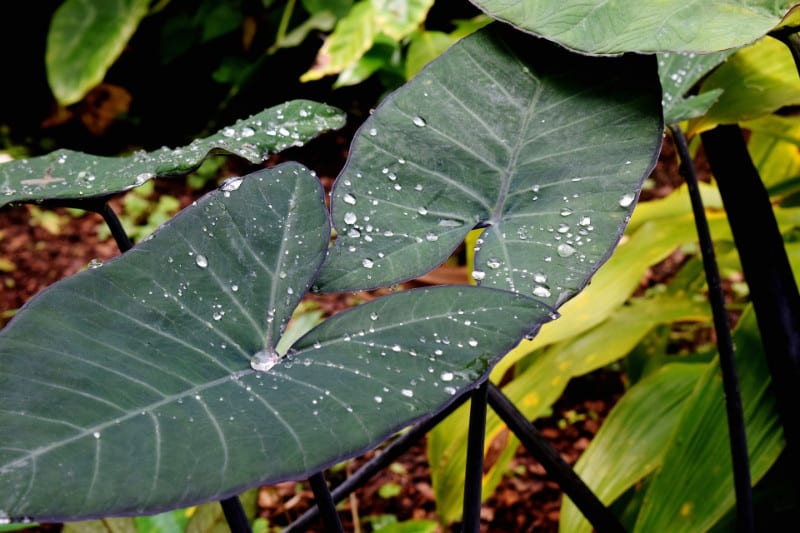Elephant ears make a beautiful addition to any garden, and with a little bit of care, they can be easy to grow. This guide will tell you everything you need to know about growing and caring for elephant ears. From planting tips to watering and fertilizing instructions, we’ll cover it all! So if you’re looking for a lush, green addition to your garden that is sure to turn heads, read on for advice on growing elephant ears.
Best Elephant Ears Varieties
| Image | Name | Rating | Shop |
|---|---|---|---|
 | Van Zyverden Jumbo Elephant Ears | ||
 | Van Zyverden Elephant Ears Diamond Head Bulbs | ||
 | Colocasia Gigantea Thailand Giant |
How to Grow and Care for Elephant Ears
Elephant Ears Hardiness Zones
Elephant ear plants are typically hardy in zones 8-11. Though it’s native to tropical regions, this hardy plant can also be grown in colder climates if brought indoors for the winter.
How Much Sun Do Elephant Ears Need
Elephant ears (Colocasia esculenta) are tropical plants that need plenty of sun to grow well. They will do best with full sun, but can also tolerate part shade. In shadier locations, they may not get as big or as lush, but they will still grow.
Elephant Ears Soil Requirements
Elephant ears need moist, fertile soil to thrive. The soil should be rich in organic matter and free of any debris or stones. A good rule of thumb is to create a mixture that is two parts topsoil to one part peat moss.
Elephant Ears Soil pH
Elephant ears (Colocasia esculenta) grow well in soil that has a pH of 5.5 to 7.0, but they prefer acidic soil. If the pH of your soil is higher than 7.0, you can lower it by adding sulfur or aluminum sulfate to the soil. You can also adjust the pH by adding organic matter to the soil, such as peat moss, leaf mold, or compost.
Elephant Ears Plant Spacing
Elephant ears should be spaced 4 to 8 feet apart, depending on the size of the plant. Larger plants should be spaced further apart than smaller plants. If you are growing them in a container, you can space them closer together (2 to 4 feet apart).
Elephant Ears Temperature Requirements
Elephant ears are tropical plants that thrive in high-temperature conditions. In fact, they will quickly go into decline if the temperature drops below 60 degrees F.
So if you live in a colder climate, you’ll need to provide proper winter protection for your elephant ears by bringing them inside or keeping them in a greenhouse.
Elephant Ears Fertilizer Requirements
Elephant ears are a high maintenance plant when it comes to fertilizer. They’re considered a “heavy feeder,” which means they require more nutrients than most plants. High nitrogen fertilizer is ideal for them, and you should fertilize them every two weeks during the growing season.
Elephant Ears Water Requirements
Elephant ears are one of those plants that really seem to vary in their water requirements. I have seen some that can survive in standing water and others that seem to prefer dryer conditions.
Container-grown plants will usually need to be watered daily unless they are receiving enough rainwater.
When it comes to planting them in the ground, it really depends on the soil type and rainfall in your area. If you have sandy soil, they will likely need more water than if you have clay soil. And if you get a lot of rain, they will probably need less supplemental watering.
The best way to figure out how much water your elephant ears need is to just keep an eye on them and see what seems to make them grow best.
Elephant Ears Humidity Requirements
Elephant ears are tropical plants that do best in high humidity. They will suffer in dry conditions and may even wilt if the air is too dry. You can increase the humidity around your plants by placing them near a water source, such as a pond or fountain, or by grouping them with other plants that release water vapor into the air.
Elephant Ear Pests
Elephant ears are susceptible to spider mites. These pests are tiny creatures that feast on plant leaves, causing them to turn yellow and eventually die. If you have elephant ears that are infested with spider mites, you’ll need to take action to get rid of them.
One of the first things you can do is try to encourage predators of spider mites to visit your plants.
Read More: What Eats Spider Mites
Elephant Ear Diseases
Elephant ears are a popular ornamental plant, but they can be susceptible to diseases. One such disease is fungal leaf blight. This fungus causes leaves to turn brown and die, and can eventually kill the plant.
Another common disease of elephant ears is Pythium rot. This fungus attacks the roots of the plant, causing them to rot and die.













